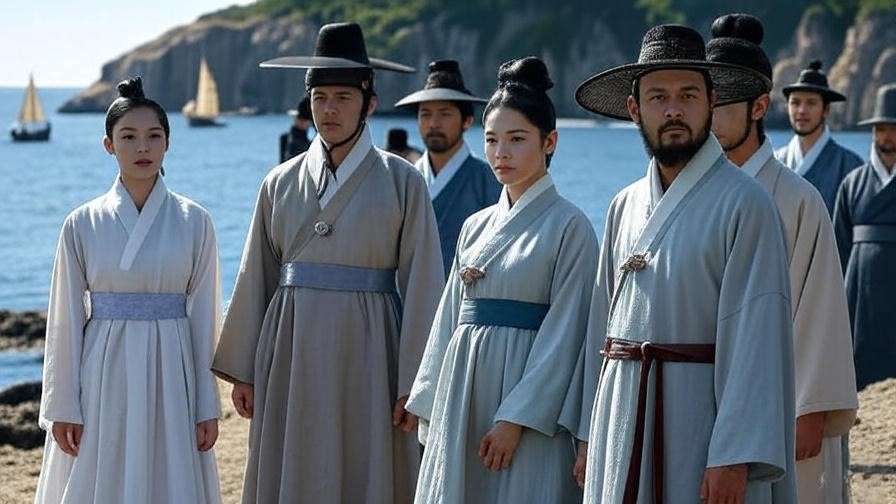Step into a world where jagged cliffs meet the whispers of ancient legends—welcome to Dagelet Island, known locally as Ulleungdo, a remote paradise in the East Sea. This hidden gem of South Korea, with its volcanic landscapes and rich cultural heritage, has captivated travelers and inspired Korean dramas alike. Dagelet Island’s serene beauty and unique history offer an escape for those seeking authentic Korean culture beyond the bustling cities. In 2024, the island welcomed over 300,000 visitors, a 15% increase from the previous year, according to the Korea Tourism Organization. This article unveils its natural wonders, cultural significance, and practical travel insights, making it an essential guide for K-Drama fans and adventurers.
Unveiling Dagelet Island: Geography and History
The Unique Geography of Dagelet Island
Dagelet Island, located 120 kilometers east of the Korean Peninsula, is a volcanic marvel rising 984 meters at its highest point, Seonginbong Peak. Its rugged terrain, formed by ancient eruptions, features dramatic cliffs, lush forests, and crystal-clear waters surrounding the nearby Dokdo islets. Spanning 73 square kilometers, the island’s isolation has preserved its pristine ecosystem, including rare flora and fauna. The Korea Tourism Organization notes its distinct microclimate, offering mild summers and snowy winters, making it a year-round destination. This natural splendor sets the stage for its cultural and cinematic allure.
A Rich Historical Tapestry
 Dagelet Island’s history stretches back to the Three Kingdoms period, with evidence of early settlements dating to 500 CE. During the Joseon Dynasty, it served as a strategic outpost against foreign invasions, its isolation adding to its mystique. Local folklore speaks of the Sea God protecting the island, a tale woven into Korean shamanistic traditions. Designated a natural monument in 1981, preservation efforts have safeguarded its heritage. Historian Dr. Kim Soo-jin from Seoul National University states, “Dagelet Island is a living museum of Korea’s maritime past, blending nature and culture seamlessly.”
Dagelet Island’s history stretches back to the Three Kingdoms period, with evidence of early settlements dating to 500 CE. During the Joseon Dynasty, it served as a strategic outpost against foreign invasions, its isolation adding to its mystique. Local folklore speaks of the Sea God protecting the island, a tale woven into Korean shamanistic traditions. Designated a natural monument in 1981, preservation efforts have safeguarded its heritage. Historian Dr. Kim Soo-jin from Seoul National University states, “Dagelet Island is a living museum of Korea’s maritime past, blending nature and culture seamlessly.”
Natural Wonders and Outdoor Adventures
Must-Visit Natural Attractions
Dagelet Island’s landscapes are a treasure trove for explorers. The Nari Basin, a volcanic crater turned verdant valley, offers breathtaking views and easy hiking trails. The Haengnam Coastal Walk, a 2-kilometer path along jagged cliffs, provides stunning photo opportunities, especially at sunset. The Haedong Seawater Hot Springs, with water temperatures reaching 70°C, offer a relaxing soak with therapeutic benefits. The Korea Tourism Organization recommends visiting in spring or autumn for optimal weather, avoiding the monsoon season from June to July.
Outdoor Activities for Adventure Seekers
 Adventure awaits with activities tailored to all levels. Kayaking around the island’s coastline reveals hidden coves, while fishing trips yield fresh catches like squid and mackerel. Bird watching is a highlight, with the Korean seagull and black-tailed gull nesting in protected areas. Local guide Park Min-ho advises, “Bring sturdy shoes and a waterproof jacket—weather can change quickly, and safety gear is essential for water activities.” These experiences connect visitors to the island’s wild beauty and biodiversity.
Adventure awaits with activities tailored to all levels. Kayaking around the island’s coastline reveals hidden coves, while fishing trips yield fresh catches like squid and mackerel. Bird watching is a highlight, with the Korean seagull and black-tailed gull nesting in protected areas. Local guide Park Min-ho advises, “Bring sturdy shoes and a waterproof jacket—weather can change quickly, and safety gear is essential for water activities.” These experiences connect visitors to the island’s wild beauty and biodiversity.
Dagelet Island’s Influence on Korean Culture
Folklore and Legends
Dagelet Island is steeped in mythology, with the tale of the Sea God Ungnyeo shaping local identity. Legend says she transformed into a bear to protect the island, a story linked to shamanistic rituals still performed today. The annual Haenyeo festival celebrates the female divers who sustain the island’s fishing tradition, a practice dating back centuries. These narratives enrich Korean cultural heritage, offering visitors a glimpse into its spiritual roots.
Artistic Inspirations and K-Drama Filming Locations
 The island’s dramatic scenery has inspired Korean artists and filmmakers. Its cliffs and seascapes feature in paintings by 20th-century artist Park Soo-keun and modern K-Pop music videos. K-Dramas like Haeundae Lovers and The Legend of the Blue Sea used Dagelet’s rugged coastlines to depict romantic and fantastical settings. Director Lee Jung-hyun notes, “The island’s untouched beauty adds an authentic layer to our storytelling, making it a perfect backdrop for emotional scenes.”
The island’s dramatic scenery has inspired Korean artists and filmmakers. Its cliffs and seascapes feature in paintings by 20th-century artist Park Soo-keun and modern K-Pop music videos. K-Dramas like Haeundae Lovers and The Legend of the Blue Sea used Dagelet’s rugged coastlines to depict romantic and fantastical settings. Director Lee Jung-hyun notes, “The island’s untouched beauty adds an authentic layer to our storytelling, making it a perfect backdrop for emotional scenes.”
Practical Guide to Visiting Dagelet Island
How to Get There
Reaching Dagelet Island requires planning. Ferries depart from Pohang or Gangneung, with a 2.5- to 3-hour journey costing around $40-$50 one-way. Ulleung Airport offers flights from Seoul, taking 50 minutes for approximately $100. Peak seasons (July-August) see high demand, so booking two months ahead is advised. Tip: Use the Korea Tourism Organization’s website to check real-time ferry schedules and secure tickets early.
Where to Stay and Eat
 Accommodations range from budget guesthouses ($30-$50/night) to eco-friendly resorts like Ulleungdo Hanhyang Resort ($150+/night). Camping is popular near Nari Basin, with permits available locally. Culinary highlights include salted squid and abalone porridge, best sampled at Seonginbong Restaurant. Chef Kim Ji-yeon shares, “Our dishes use fresh, local ingredients, reflecting the island’s sustainable lifestyle—try the seaweed soup for a true taste.”
Accommodations range from budget guesthouses ($30-$50/night) to eco-friendly resorts like Ulleungdo Hanhyang Resort ($150+/night). Camping is popular near Nari Basin, with permits available locally. Culinary highlights include salted squid and abalone porridge, best sampled at Seonginbong Restaurant. Chef Kim Ji-yeon shares, “Our dishes use fresh, local ingredients, reflecting the island’s sustainable lifestyle—try the seaweed soup for a true taste.”
Travel Tips for a Seamless Experience
Weather can be unpredictable, with average temperatures ranging from 2°C in winter to 22°C in summer. Visitors need a travel permit, obtainable online via the Ulleung County website for a small fee. English signage is limited, so a translation app is helpful. Checklist: Pack sunscreen, rain gear, comfortable shoes, and a power bank for remote areas.
Dagelet Island in Modern Korean Media
K-Dramas and Movies Set on the Island
Dagelet Island’s cinematic allure shines through its appearances in Korean media. In Haeundae Lovers (2012), the island’s coastal cliffs provided a dramatic backdrop for a fisherman’s love story, with scenes filmed near Haengnam. The Legend of the Blue Sea (2016) used its serene waters to depict a mythical underwater kingdom, boosting its fame among global fans. These portrayals highlight the island’s versatility, from rugged adventure to ethereal romance. The increased visibility has led to a 20% rise in tourism since 2016, per local government reports, as viewers seek to experience these settings firsthand.
Impact on K-Culture Fans
For K-Drama enthusiasts, Dagelet Island is a pilgrimage site, where fans recreate iconic scenes or explore filming locations. Social media platforms like Instagram feature hashtags like #UlleungdoAdventures, with over 50,000 posts in 2024. This fan-driven tourism has injected $2 million annually into the local economy, supporting small businesses. Tourism expert Dr. Lee Hye-rin from Yonsei University observes, “K-Culture fans are driving sustainable tourism, creating a feedback loop that preserves the island while promoting its heritage.”
Challenges and Preservation Efforts
Environmental and Cultural Challenges
 Dagelet Island faces pressures from over-tourism, with visitor numbers jumping from 250,000 in 2019 to 300,000 in 2024. Climate change threatens its ecosystem, with rising sea levels eroding coastal paths. The influx of visitors also risks cultural dilution, challenging traditional practices like Haenyeo diving. Local authorities allocate $500,000 yearly for conservation, focusing on habitat restoration and waste management, according to the Ulleung County Office.
Dagelet Island faces pressures from over-tourism, with visitor numbers jumping from 250,000 in 2019 to 300,000 in 2024. Climate change threatens its ecosystem, with rising sea levels eroding coastal paths. The influx of visitors also risks cultural dilution, challenging traditional practices like Haenyeo diving. Local authorities allocate $500,000 yearly for conservation, focusing on habitat restoration and waste management, according to the Ulleung County Office.
Future Prospects for Dagelet Island
The island’s potential UNESCO World Heritage status could elevate its global profile, with a nomination process underway since 2023. Sustainable tourism initiatives, including eco-friendly transport and visitor caps, aim to balance growth and preservation. The Korea Tourism Organization projects 400,000 visitors by 2030, provided conservation efforts succeed. These steps ensure Dagelet remains a cultural and natural treasure for future generations.
Why Dagelet Island Matters to K-Culture Enthusiasts
Dagelet Island embodies the essence of K-Culture, where nature’s grandeur meets the storytelling magic of K-Dramas. Its legends and landscapes deepen fans’ appreciation of Korean narratives, from mythical tales to on-screen romance. Visiting the island or watching related dramas offers a tangible connection to South Korea’s cultural exports. Call-to-action: Plan your trip to Dagelet Island or rewatch The Legend of the Blue Sea to spot its scenic beauty—share your plans in the comments!
FAQs
What is the best time to visit Dagelet Island?
The ideal times are spring (April-May) for cherry blossoms and autumn (September-October) for mild weather and vibrant foliage. Avoid July-August due to monsoons.
Do I need a special permit to visit?
Yes, a travel permit is required, obtainable online via the Ulleung County website for a $5 fee, processed within 24 hours.
Are there K-Drama filming locations I can visit?
Yes, explore Haengnam Coastal Walk and Nari Basin, featured in Haeundae Lovers and The Legend of the Blue Sea. Stick to marked paths for safety.
What makes Dagelet Island unique compared to other Korean islands?
Its volcanic origins, rich mythology, and K-Drama fame distinguish it from Jeju or Ganghwado, offering a blend of adventure and cultural depth.
How can I travel sustainably to Dagelet Island?
Opt for ferries over flights, use eco-lodges, and minimize plastic waste. Support local businesses to reduce your carbon footprint.
Dagelet Island, or Ulleungdo, stands as a hidden gem where natural beauty and Korean cultural heritage intertwine. From its volcanic landscapes and historical significance to its starring role in K-Dramas like The Legend of the Blue Sea, the island offers a unique escape for travelers and fans. This guide equips you with the knowledge to visit responsibly, appreciate its cultural roots, and support its preservation. Join the conversation: Which K-Drama scene from Dagelet Island excites you most? Share below or follow the Korea Tourism Organization for updates. As K-Culture grows globally, Dagelet Island’s legacy shines as a beacon of sustainable storytelling.




